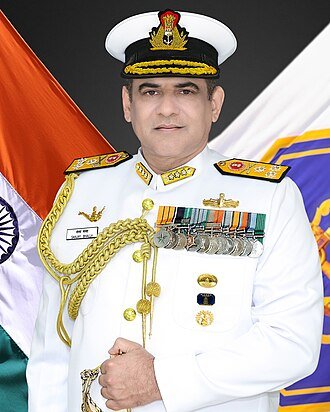






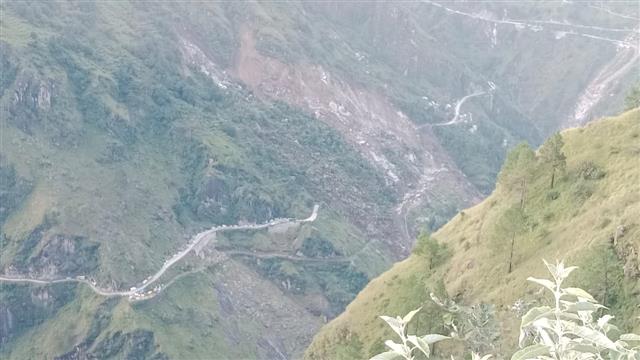
Subhash Rajta
Shimla, September 8
Kinnaur and Spiti valley has been cut off from the rest of the state after a stretch of 150 metres road on the National Highway 5 sunk near Nigulsari.
About strech completely caved in, thus, halting the vehicular movement to Spiti.
According to officials, the movement of vehicles was stopped last night. The hill side had been sinking for the last two days. There is no alternate route to Kinnaur.

A stretch of about 150-300 metre of the NH has been badly damaged, K L Suman, executive engineer, National Highways Authority of India (NHAI), said, adding that it is not even possible to cross the stretch on foot.
A large number of vehicles, including apple-laden trucks coming from Kinnaur, are stranded on the road. The apple growers are worried as their produce will rot if the road is not opened soon. Machinery and manpower have been deployed, but stones falling from the hills are obstructing the road opening work, the officials said.
Horticulture and Tribal Development Minister Jagat Singh Negi, who is also the MLA from Kinnaur, visited the spot and directed officials to clear the road on a war footing.
He inspected the spot with the help of drone cameras and directed the officials to arrange for the trans-shipment (buses and vehicles stuck on the Kinnaur side would take passengers coming from Shimla and move back towards Kinnaur and vice versa) of passengers and goods.
There are 17,120 landslide-prone sites in the hill state, including 675 located near critical infrastructure and habitations. Negulsari is among the 15 such prioritised sites in the tribal district of Kinnaur. The other significant spots in the district include Urni Dhank, Batsari, Nesang and Purbani Julha.
Imphal, September 8
Two persons were killed and nearly 50 injured in two different firing incidents at Pallel in Manipur’s Tengnoupal district on Friday, officials said.
Among the injured, four civilians sustained bullet wounds, they said.
Firing between two groups of unidentified men began at Pallel around 6 am leading to the death of a person, officials added.
He was brought dead to Kakching Jeevan Hospital while the injured who received bullet injuries have been referred to Imphal, they added.
The condition of one of the injured admitted to Regional Institute of Medical Sciences (RIMS) in Imphal is critical, doctors said.
As news of the firing spread, a large number of people from different sides of Thoubal and Kakching districts rushed to Pallel but were stopped by Assam Rifles personnel leading to the tense face off, officials said.
A 48-year-old man was killed in the crossfire between the two groups of unidentified armed men, officials said.
More than 45 women were also injured after Assam Rifles lobbed teargas shells to defuse the situation, officials said. An Assam Rifles jawan was also injured, they added.
On the other hand, a contingent of RAF personnel heading to Pallel from Imphal to contain the mob was blocked by locals at Thoubal.
Situation is still tense and firing has temporarily stopped, officials said.
This comes two days after thousands of protesters gathered at Phougakchao Ikhai in Bishnupur district on Wednesday and tried to break through army barricades in an attempt to reach their deserted houses in Torbung.
A day before the protest, full curfew had been clamped in all the five valley districts of Manipur as a preventive measure.
More than 160 people have been killed and several hundreds injured since ethnic violence broke out in Manipur on May 3, when a “Tribal Solidarity March” was organised in the hill districts to protest against the majority Meitei community’s demand for Scheduled Tribe status.
Meiteis account for about 53 per cent of Manipur’s population and live mostly in the Imphal valley, while tribals, including Nagas and Kukis, constitute 40 per cent and reside mostly in the hill district.
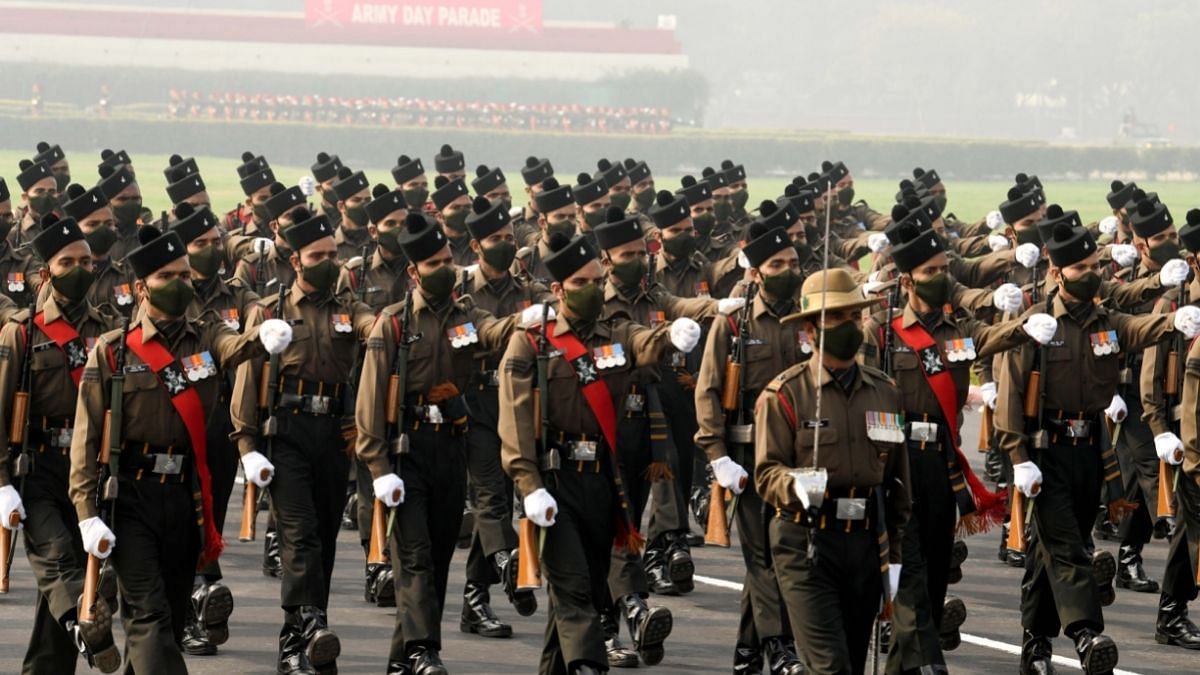
n May 2023, Army Headquarters recommended—‘directed’ in military terms—that “every soldier proceeding on leave volunteers to choose any subject/domain as per own interest/competency and the felt need of one’s local community and engages citizens, thereby making an individual contribution to the Indian Army’s nation-building effort”.
The letter, issued by the Ceremonials and Welfare Directorate of the Adjutant General’s Branch, elaborates on the ‘nation-building effort’ in terms of social, civic, and patriotic themes. It also specifies the need for the propagation of the plethora of welfare schemes of the Narendra Modi government. The policy was to be implemented with immediate
The Army has a liberal leave policy to compensate for the rigours of service and long separation from families due to field/operational tenures, and limited family accommodation in peace areas. All personnel are entitled to two months of annual leave and casual leave of 30 days (20 days for officers). Leave is considered the sine qua non of welfare, especially when not getting timely leave is one of the causes of suicide among military personnel. On the face of it, the noble intent of the ‘social warrior’ policy cannot be faulted. However, closer scrutiny makes the scheme controversial both in concept and in execution.
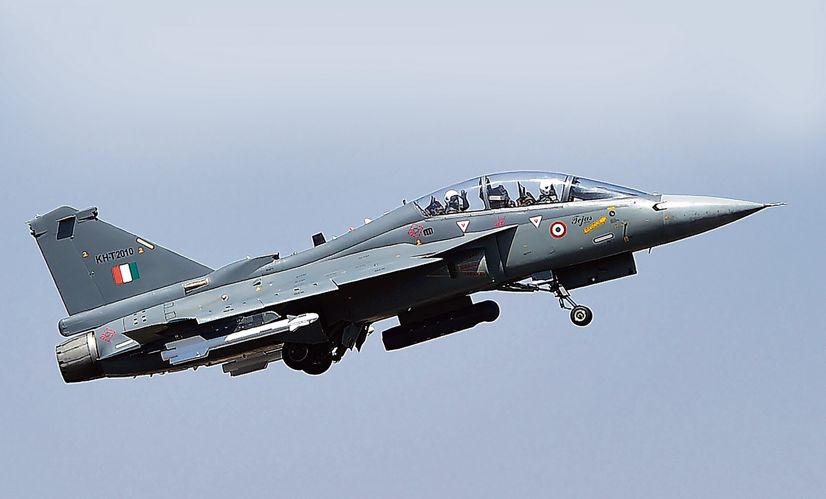
Mentioning technology for making engines for fighter jets, the US on Friday said it was committed to working collaboratively and expeditiously to support the advancement of an “unprecedented co-production and technology transfer proposal”.
Tribune News Service
Ajay Banerjee
New Delhi, September 8
Mentioning technology for making engines for fighter jets, the US on Friday said it was committed to working collaboratively and expeditiously to support the advancement of an “unprecedented co-production and technology transfer proposal”.
This emerged in a joint statement issued after a bilateral meeting between PM Narendra Modi and US President Joe Biden here tonight.
The two welcomed the completion of the US congressional notification process on August 29 and the commencement of negotiations for a commercial agreement between GE Aerospace and Hindustan Aeronautical Limited (HAL) to manufacture GE F-414 jet engines in India.
India has set a target to get the first made-in-India GE engine, the F-414, in three years, even as the US company will transfer technology for about 80 per cent of its engine, including critical and restricted technologies.
Some of these technologies are among the most elusive and only the US, France, the UK and Russia have these. “India will be getting the technology that has never been transferred to any country,” a top defence functionary said.
The GE F414 engines are compatible with the light combat aircraft Tejas Mark 2, the forthcoming twin-engine deck-based fighter jet of the Indian Navy and also the initial lot of the advanced medium combat aircraft (AMCA).
President Biden also welcomed the issuance of a letter of request from the Indian Ministry of Defence to procure 31 General Atomics MQ-9B armed drones and their associated equipment, which will enhance the intelligence, surveillance and reconnaissance (ISR) capabilities of the Indian armed forces.
Last month, the US Navy signed a master ship repair agreement with Mazgaon Dock Shipbuilders Ltd. Today, the joint statement said, “Both sides recommitted to advancing India’s emergence as a hub for the maintenance and repair of forward-deployed US Navy assets and other aircraft and vessels.”
The two sides reiterated their support for building resilient global semiconductor supply chains. US firm Micron announced to invest approximately $300 million in expanding its R&D presence in India and Advanced Micro Device’s announcement to invest $400 million in India over five years to expand R&D and engineering operations in India.
Modi and Biden also welcomed the signing of an MoU between Bharat 6G Alliance and Next G Alliance, operated by Alliance for Telecommunications Industry Solutions.
India in select club
31 hi-tech drones on way
India to procure 31 General Atomics MQ-9B armed drones and associated equipment to enhance intelligence, surveillance and reconnaissance capabilities of its armed forces
ANI
New Delhi, September 8
Asserting that no form of extremism or violence is acceptable in the United Kingdom, British Prime Minister Rishi Sunak has said that his government is working closely with the Indian government to particularly tackle pro-Khalistan extremism and it will not be tolerated.
In an exclusive interview with ANI, Sunak also spoke about his sense of pride in his Indian roots and the FTA negotiations between the two countries.
Answering a question about concerns in India about activities of pro-Khalistani elements in Britain, the UK Prime Minster said the two countries have working groups to share intelligence and information so that this kind of violent extremism can be rooted out.
“It’s a really important question and let me just say unequivocally that no form of extremism or violence like that is acceptable in the UK. And that’s why we are working very closely with the Indian government to particularly tackle ‘PKE’ Pro-Khalistan Extremism,” Rishi Sunak told ANI.
ANI

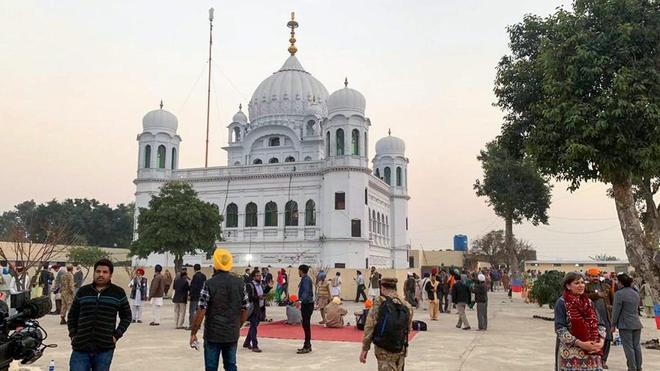
Lahore, September 8
Pakistan has started the construction of a Cultural Theme Park at Kartarpur Corridor (Gurdwara Darbar Sahib) in Punjab province to woo more pilgrims to the revered place of worship for the Sikhs.
The foundation stone for the project was laid by the country’s caretaker federal religious minister Aneeq Ahmad during his visit to the Karatarpur Sahib on Thursday. He also met visiting Sikh Yatrees from India and asked them about facilities at the gurdwara.
The theme park was launched by the Project Management Unit (PMU) Kartarpur Corridor in collaboration with a private company.
Homeland Group’s Iqbal Sindhu told PTI on Friday that the first phase of the project will be completed in six months. However, the total project will see its completion in three years.
“In the first phase, restaurants, food street, play area, cultural music arena, and shops of the Cultural Theme Park will be completed and opened for the visiting pilgrims,” Sidhu said.
Beyond housing joy land attractions, rides for families and children, food streets, restaurants, and heritage shops, the park will boost up an array of enticing features which include a Water Park, Mini Zoo, Heritage Club, Regional Sports Centre, Heritage Village, Cottages & Resorts, and even a circus, he said.
The corridor was inaugurated on November 9, 2019, by then prime minister Imran Khan as part of the commemoration of the 550th birth anniversary of Guru Nanak.
The 4 km-long Kartarpur Corridor provides visa-free access to Indian Sikh pilgrims to visit Gurdwara Darbar Sahib. Sikhism founder Baba Guru Nanak lived and died at this gurdwara at the start of the 16th century.

How Xi’s non-presence at New Delhi G20 summit will save blushes for both India and China First Post 07 Sep 2023
It is now official. Xi Jinping, the Chinese President will not be attending the G20 summit. Fareed Zakaria, a veteran journalist and geopolitical expert, stated in an interview that Xi Jinping missing the summit implies that China is ‘deliberately not trying to resolve the border issue’ with India. He added, ‘This (G2O Summit) is a big deal for Prime Minister Modi personally, and for XI to snub him that way is a very powerful thing.’ The world mistakenly believes that Xi’s primary reason for missing the summit is that China seeks to lower Indian success of its presidency. India is possibly the only country which, during its leadership, compelled the G20 to devote attention to concerns of the global south.
The Chinese spokesperson, sidestepped questions on reasons why their President is absenting himself, by stating, ‘The Group of 20 is a major forum for international economic cooperation, and China has always attached great importance to and actively participated in relevant activities.’ He added that Xi Jinping will be represented by the Chinese premier, Li Qiang. China had earlier skipped G20 preliminary meetings in Arunachal, Kashmir and Leh, as also raised concerns on these locations, which were ignored.
Some assume that the Chinese President is preoccupied with the Chinese economy moving downhill as companies face unprecedented losses or closures resulting in increased unemployment, enhancing anger and resentment amongst the younger population. There is also a thought that he has health issues, based on his unsteady walk during the recently concluded BRICS summit in Johannesburg.
With Indo-China relations moving downhill, India is displaying its anti-China stance aggressively, something China dislikes. Delhi sent its three former service chiefs to attend the Ketagalan Forum’s 2023 Indo-Pacific Security Dialogue in Taiwan. The three even posted an image of their presence on multiple social media platforms. Admiral Karambir also participated in a panel discussion. The Chinese foreign ministry protested with its spokesperson, Wang Wenbin, mentioning that China firmly opposes all forms of official interaction with Taiwan.
Subsequently, General Naravane, the former army chief, shared the dais with Geshe Lobsang, representative of the Tibetan Parliament in Exile, and Umit Hamit, a noted Uyghur freedom fighter at the 6th International Rangzen (Independence) Conference in New Delhi. In his address General Naravane stated, ‘It was Tibet which was our rightful neighbour and not China. With the forceful occupation of Tibet, their rights have been suppressed.’ Both these events would have had the blessing of the government.
These sent a message to China that India can re-alter its one-China policy as also is unwilling to respect Beijing’s sentiments and redlines. India also officially backed the Philippines in its recent standoff with the Chinese coastguard in the South China Sea, an act it rarely does. These occurring close to the G20 summit displayed that India does not consider its ties with China as ‘normal,’ something Beijing would have noted.
Few have considered Xi Jinping missing the summit from Beijing’s point of view. The G20 summit is in New Delhi and Indo-China relations have slid further down post the tete-a-tete on the sidelines of the BRICS summit between Indian PM Narendra Modi and Xi Jinping. Both nations gave their own versions of the discussion, with India indicating positivity in resolving the LAC standoff, hinting at a possible Xi-Modi summit in Delhi. The Chinese changed their statement a day later, re-insisting that border and diplomatic ties should not be linked, pushing away any hopes of a bilateral. Talks at the military and diplomatic level to resolve the standoff have not made much headway.
Xi, who expects to be treated as royalty wherever he visits, considering the clout of China and his position as its emperor, may be disappointed in New Delhi. PM Modi would have accorded all due protocol on reception and departure as per global norms. However, with bonhomie lacking there would be distance maintained by the host. A mandated bilateral or even a pull-aside is unlikely, making Xi feel unwelcome. This would be unacceptable to Beijing.
China realizes that this is an election year in India and all political parties would be closely watching how Modi would handle Xi. Any display of familiarity or proximity would be exploited by the opposition, and this is not something Modi would risk. He would prefer keeping a distance rather than be subjected to a barrage of accusations from the opposition. For Xi, it would be easier skipping the summit without assigning a reason, allowing speculations to run wild, with many believing that his absence is an insult to India, rather than attend and be ignored.
With Russia and China against any mention of Ukraine, the statement is likely to be watered down. Indian proposals on including its thoughts and vision of the organization would face resistance only from China. Common issues including the inclusion of the African Union may be acceptable. The joint statement is being discussed in the final Sherpa’s meeting currently under progress and would not be impacted by the absence of Xi.
The Chinese premier, Li Qiang, would read out the message which Xi was to have done. His being ignored in Delhi is acceptable to Beijing as he remains only a mouthpiece for the Chinese president with largely a ceremonial role.
Russian President Putin spoke to PM Modi and conveyed reasons for his absence. This displayed proximity of ties. Xi cannot resort to the same as Indo-China ties are in the dumps and a conversation would result in divulging true reasons for missing the event.
India has rejected the hybrid format which includes online presence mainly to ignore the request of Ukrainian President, Zelensky, to address the summit. Hence, leaders will not have the option of speaking online. The Indian government also cannot comment on why heads of state are not attending. It is their spokespersons who justify. Thus, Jaishankar stated, ‘I would say rather than focus necessarily on which country chose to come at what level, the real issue is what position they take when they come.’
For India, Xi or no Xi, the summit will showcase efforts put forth by the country during the past year in making the G20 into an organization accountable to the world. At the end of the day, the non-presence of the Chinese leader will save blushes for himself and the Indian PM, as both would feel awkward in each other’s presence as also would hesitate to exchange even a few words as these could be twisted or misconstrued.
























